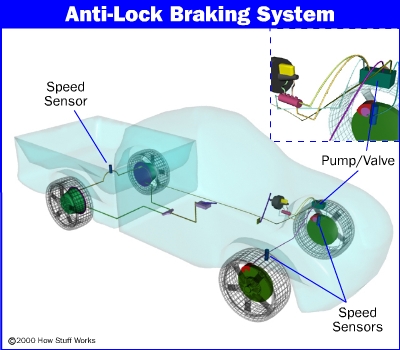What is ABS | Anti-lock brake system
ABS stands for anti-lock brake system, it is a automotive safety system and as its name indicates it is a system which prevents locking of wheels during braking.
Whenever harsh brakes are applied during high speed tires loses traction with the road surface resulting in the skidding of the wheels and skidding is very dangerous for automobiles especially at corners. For 2 wheeler it’s even worse.
This is where the anti-lock braking system (ABS) comes in. It prevents the wheels from locking up and helps them maintain grip with the road below and it also helps reducing the stopping distance. Without ABS even a experienced driver can fail sometimes and with ABS equipped vehicle pro-drivers can handle the braking.

Anti-lock brake system works on the principle of threshold braking. Threshold braking is a technique in which brakes are applied in fluctuating manner i.e. After applying full brake, brake is released before locking.
In other words ,whenever brakes are applied, the pressure is transferred in pulses and brake is fully applied and released continuously.
Components of Anti-lock braking system
- Speed sensors : Speed sensors of ABS system is different from the sensors which shows the moving speed of vehicle. Main function of this sensor is to observe the speed variations of each wheel independently and then send this information data to the electronic control unit of Anti-lock braking system.
These sensors are placed independently at different wheels to observe the variations differently These sensors are consist of electromagnet coil which rotates with the wheels and generates voltage difference which is then after conversion into information sent to the ECU. - Valves: Valves are incorporated with each brake line and function of this valve is to release the pressure from the brake lines whenever command is given by the electronic control unit. Valve has three working conditions, one is when valve is in open condition and pressure from the master cylinder is supplied to the brakes directly. Second condition is when the valve is in closed condition and pressure from master cylinder is blocked to flow to brakes and in 3rd condition pressure is released from the brake line.
- Pump:
Pump refills the brake line when pressure is released from valve. When wheels are about to lock ECU sends command to valve to releases the pressure from the line and after which role of pump comes into play. To maintain the desired pressure within line ECU send command just after the release of pressure to Pump to refill the pressure within line. - ECU (Electronic control unit):
ECU is the central unit of the ABS system. Its function is to collect data from all of the units and after interpreting according to installed program it sends command to the units independently for complete ABS operation.
Click here to learn more about ABS.



